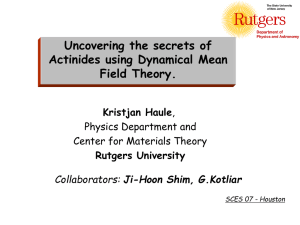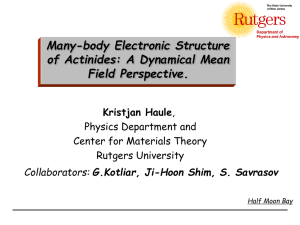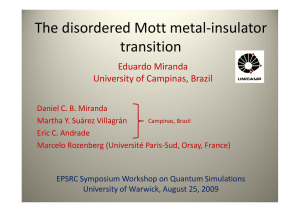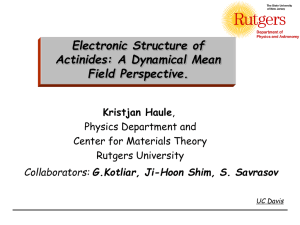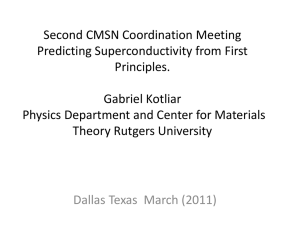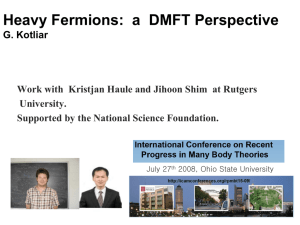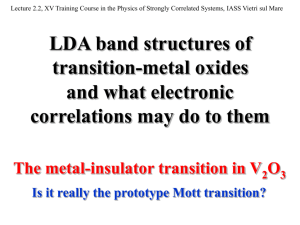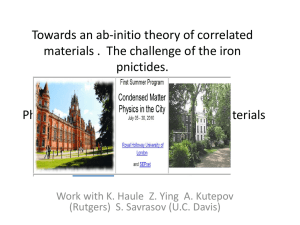Electronic structure of Strongly Correlated Materials: A Dynamical Mean Field Perspective.
advertisement
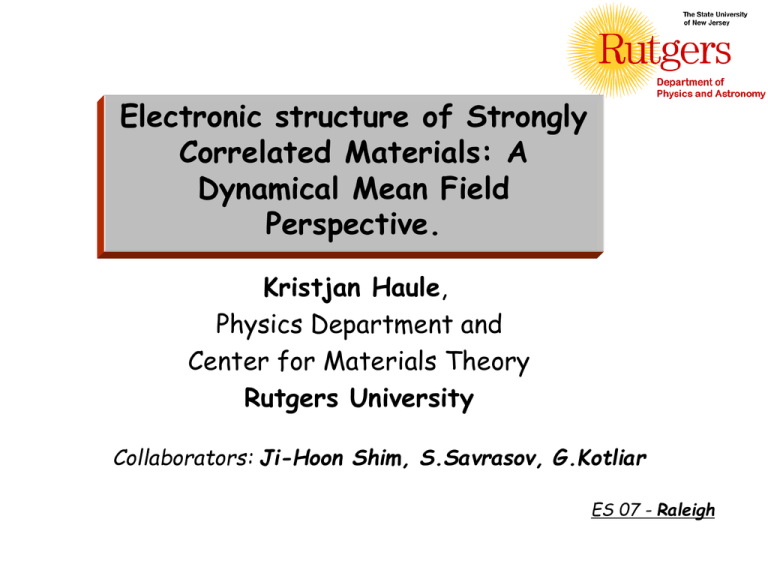
Electronic structure of Strongly Correlated Materials: A Dynamical Mean Field Perspective. Kristjan Haule, Physics Department and Center for Materials Theory Rutgers University Collaborators: Ji-Hoon Shim, S.Savrasov, G.Kotliar ES 07 - Raleigh Standard theory of solids Band Theory: electrons as waves: Rigid non-dipersive band picture: En(k) versus k Landau Fermi Liquid Theory applicable Very powerful quantitative tools: LDA,LSDA,GW Predictions: •total energies, •stability of crystal phases •optical transitions •…… Strong correlation – Standard theory fails • Fermi Liquid Theory does NOT work . Need new concepts to replace rigid bands picture! • Breakdown of the wave picture. Need to incorporate a real space perspective (Mott). • Non perturbative problem. Universality of the Mott transition Crossover: bad insulator to bad metal Critical point First order MIT V2O3 1B HB model (DMFT): Ni2-xSex k organics Delocalization Localization Basic questions • How to describe the physics of strong correlations close to the Mott boundary? • How to computed spectroscopic quantities (single particle spectra, optical conductivity phonon dispersion…) from first principles? • New concepts, new techniques….. DMFT maybe simplest approach to meet this challenge DMFT + electronic structure method Basic idea of DMFT: reduce the quantum many body problem to a problem of an atom in a conduction band, which obeys DMFT self-consistency condition (A. Georges et al., RMP 68, 13 (1996)). DMFT in the language of functionals: DMFT sums up all local diagrams in BK functional Basic idea of DMFT+electronic structure method (LDA or GW): For less correlated bands (s,p): use LDA or GW For correlated bands (f or d): with DMFT add all local diagrams (G. Kotliar S. Savrasov K.H., V. Oudovenko O. Parcollet and C. Marianetti, RMP 2006). Effective (DFT-like) single particle spectrum consists of delta like peaks DMFT stectral function contains renormalized quasiparticles and Hubbard bands LDA+DMFT (G. Kotliar et.al., RMP 2006). observable of interest is the "local“ Green's functions (spectral function) Exact functional of the local Green’s function exists, its form unknown! Currently Feasible approximations: LDA+DMFT: LDA functional ALL local diagrams Variation gives st. eq.: Generalized Q. impurity problem! Exact “QMC” impurity solver, expansion in terms of hybridization K.H. Phys. Rev. B 75, 155113 (2007) P. Werner, Phys. Rev. Lett. 97, 076405 (2006) General impurity problem k Diagrammatic expansion in terms of hybridization D +Metropolis sampling over the diagrams •Exact method: samples all diagrams! •Allows correct treatment of multiplets Volume of actinides Trivalent metals with nonbonding f shell f’s participate in bonding Partly localized, partly delocalized Anomalous Resistivity Maximum metallic resistivity: s=e2 kF/h Fournier & Troc (1985) Dramatic increase of specific heat Heavy-fermion behavior in an element NO Magnetic moments! Pauli-like from melting to lowest T No curie Weiss up to 600K Curium versus Plutonium nf=6 -> J=0 closed shell (j-j: 6 e- in 5/2 shell) (LS: L=3,S=3,J=0) One hole in the f shell No magnetic moments, large mass Large specific heat, Many phases, small or large volume One more electron in the f shell Magnetic moments! (Curie-Weiss law at high T, Orders antiferromagnetically at low T) Small effective mass (small specific heat coefficient) Large volume Standard theory of solids: DFT: All Cm, Am, Pu are magnetic in LSDA/GGA LDA: Pu(m~5mB), Am (m~6mB) Cm (m~4mB) Exp: Pu (m=0), Am (m=0) Cm (m~7.6mB) Non magnetic LDA/GGA predicts volume up to 30% off. In atomic limit, Am non-magnetic, but Pu magnetic with spin ~5mB Many proposals to explain why Pu is non magnetic: Mixed level model (O. Eriksson, A.V. Balatsky, and J.M. Wills) (5f)4 conf. +1itt. LDA+U, LDA+U+FLEX (Shick, Anisimov, Purovskii) (5f)6 conf. Cannot account for anomalous transport and thermodynamics Can LDA+DMFT account for anomalous properties of actinides? Can it predict which material is magnetic and which is not? Very strong multiplet splitting Atomic multiplet splitting crucial -> splits Kondo peak Atom F2 F4 F6 x U 8.513 5.502 4.017 0.226 93 Np 9.008 5.838 4.268 0.262 94 Pu 8.859 5.714 4.169 0.276 95 Am 9.313 6.021 4.398 0.315 96 Cm 10.27 6.692 4.906 0.380 Used as input to DMFT calculation - code of R.D. Cowan Increasing F’s an SOC N 92 Starting from magnetic solution, Curium develops antiferromagnetic long range order below Tc above Tc has large moment (~7.9mB close to LS coupling) Plutonium dynamically restores symmetry -> becomes paramagnetic DOS (states/eV) DOS (states/eV) 4 -Plutonium 3 Total DOS f DOS 2 1 0 4 -6 -4 Curium -2 0 Total DOS f, J=5/2,jz<0 f, J=7/2,jz<0 3 2 2 f, J=5/2,jz>0 f, J=7/2,jz>0 4 6 4 6 1 0 -6 -4 -2 0 ENERGY (eV) 2 J.H. Shim, K.H., G. Kotliar, Nature 446, 513 (2007). Multiplet structure crucial for correct Tk in Pu (~800K) and reasonable Tc in Cm (~100K) Without F2,F4,F6: Curium comes out paramagnetic heavy fermion Plutonium weakly correlated metal DOS (states/eV) DOS (states/eV) 4 -Plutonium 3 Total DOS f DOS 2 1 0 4 -6 -4 Curium -2 0 Total DOS f, J=5/2,jz<0 f, J=7/2,jz<0 3 2 2 f, J=5/2,jz>0 f, J=7/2,jz>0 4 6 4 6 1 0 -6 -4 -2 0 ENERGY (eV) 2 Magnetization of Cm: Valence histograms Density matrix projected to the atomic eigenstates of the f-shell (Probability for atomic configurations) f electron fluctuates between these atomic states on the time scale t~h/Tk (femtoseconds) Pu partly f5 partly f6 J=6,g =1 J=5/2, g =0 J=7/2,g =0 J=9/2,g =0 J=0,g =0 J=1,g =0 J=2,g =0 J=3,g =0 J=4,g =0 J=5,g =0 J=4,g =0 0.3 J=5,g =0 Nf =6 Nf =5 Nf =4 J -Plutonium J=3,g =1 J=2,g =1 J=1,g =0 J=2,g =0 Probability 0.6 •5 electrons 80% Nf =6 •6 electrons 20% J=6,g =0 J=5,g =0 J=4,g =0 J=3,g =0 J=2,g =0 0.3 J=7/2,g =0 Curium 0.6 Probabilities: Nf =8 Nf =7 J=6,g =0 J=5,g =0 J=4,g =0 J=3,g =0 J=2,g =0 J=1,g =0 J=0,g =0 Probability 0.0 0.9 •4 electrons <1% 0.0 -6 -4 -2 0 ENERGY (eV) 2 4 6 One dominant atomic state – ground state of the atom J.H. Shim, K. Haule, G. Kotliar, Nature 446, 513 (2007). Fingerprint of atomic multiplets - splitting of Kondo peak Gouder , Havela PRB 2002, 2003 Photoemission and valence in Pu |ground state > = |a f5(spd)3>+ |b f6 (spd)2> Af(w) approximate decomposition f5<->f6 f5->f4 f6->f7 Probe for Valence and Multiplet structure: EELS&XAS 5f7/2 A plot of the X-ray absorption as a function of energy 5f5/2 4d5/2->5f7/2 & 4d5/2->5f5/2 hv 4d3/2 4d5/2 Core splitting~50eV Excitations from 4d core to 5f valence core valence Electron energy loss spectroscopy (EELS) or X-ray absorption spectroscopy (XAS) Measures unoccupied valence 5f states Probes high energy Hubbard bands! 4d3/2->5f5/2 Core splitting~50eV Energy loss [eV] Branching ration B=A5/2/(A5/2+A3/2) B=B0 - 4/15<l.s>/(14-nf) 2/3<l.s>=-5/2(B-B0) (14-nf) LDA+DMFT One measured quantity B, two unknowns Close to atom (IC regime) Itinerancy tends to decrease <l.s> [a] G. Van der Laan et al., PRL 93, 97401 (2004). [b] G. Kalkowski et al., PRB 35, 2667 (1987) [c] K.T. Moore et al., PRB 73, 33109 (2006). [d] K.T. Moore et al., PRL in press Specific heat Could Pu be close to f6 like Am? (Shick, Anisimov, Purovskii) (5f)6 conf Purovskii et.al. cond-mat/0702342: f6 configuration gives smaller g in Pu than a Pu Americium f6 -> L=3, S=3, J=0 Mott Transition? "soft" phase f localized "hard" phase f bonding A.Lindbaum, S. Heathman, K. Litfin, and Y. Méresse, Phys. Rev. B 63, 214101 (2001) J.-C. Griveau, J. Rebizant, G. H. Lander, and G.Kotliar Phys. Rev. Lett. 94, 097002 (2005) Am within LDA+DMFT Large multiple effects: F(0)=4.5 eV S. Y. Savrasov, K.H., and G. Kotliar Phys. Rev. Lett. 96, 036404 (2006) F(2)=8.0 eV F(4)=5.4 eV F(6)=4.0 eV Am within LDA+DMFT from J=0 to J=7/2 Comparisson with experiment V=V0 Am I V=0.76V0 Am III V=0.63V0 Am IV nf=6.2 nf=6 •“Soft” phase not in local moment regime since J=0 (no entropy) •"Hard" phase similar to Pu, Kondo physics due to hybridization, however, nf still far from Kondo regime Exp: J. R. Naegele, L. Manes, J. C. Spirlet, and W. Müller Phys. Rev. Lett. 52, 1834-1837 (1984) Theory: S. Y. Savrasov, K.H., and G. Kotliar Phys. Rev. Lett. 96, 036404 (2006) What is captured by single site DMFT? •Captures volume collapse transition (first order Mott-like transition) •Predicts well photoemission spectra, optics spectra, total energy at the Mott boundary •Antiferromagnetic ordering of magnetic moments, magnetism at finite temperature •Branching ratios in XAS experiments, Dynamic valence fluctuations, Specific heat •Gap in charge transfer insulators like PuO2 Beyond single site DMFT What is missing in DMFT? •Momentum dependence of the self-energy m*/m=1/Z •Various orders: d-waveSC,… •Variation of Z, m*,t on the Fermi surface •Non trivial insulator (frustrated magnets) •Non-local interactions (spin-spin, long range Columb,correlated hopping..) Present in DMFT: •Quantum time fluctuations Present in cluster DMFT: •Quantum time fluctuations •Spatially short range quantum fluctuations Plaquette DMFT for the Hubbard model as relevant for cuprates Large onsite component anomalous SE-SC Small next-nearest neighbor component (except in the underdoped regime) Complicated Fermi surface evolution with temperature underoped phase “fermi arcs” “arcs” decrease with T Superconducting phasebanana like Fermi surface Conclusion • Pu and Am (under pressure) are unique strongly correlated elements. Unique mixed valence. • They require, new concepts, new computational methods, new algorithms, DMFT! • Cluster extensions of DMFT can describe many features of cuprates including superconductivity and gapping of fermi surface (pseudogap) Many strongly correlated compounds await the explanation: CeCoIn5, CeRhIn5, CeIrIn5 Photoemission of CeIrIn5 Photoemission of CeIrIn5 LDA+DMFT DOS Comparison to experiment Optics of CeIrIn5 LDA+DMFT Experiment: K.S. Burch et.al., cond-mat/0604146 Optimal doping: Coherence scale seems to vanish underdoped scattering at Tc optimally Tc overdoped New continuous time QMC, expansion in terms of hybridization Diagrammatic expansion in terms of hybridization D +Metropolis sampling over the diagrams Contains all: “Non-crossing” and all crossing diagrams! Multiplets correctly treated k General impurity problem Conclusions • LDA+DMFT can describe interplay of lattice and electronic structure near Mott transition. Gives physical connection between spectra, lattice structure, optics,.... – Allows to study the Mott transition in open and closed shell cases. – In actinides and their compounds, single site LDA+DMFT gives the zero-th order picture • 2D models of high-Tc require cluster of sites. Some aspects of optimally doped regime can be described with cluster DMFT on plaquette: – Large scattering rate in normal state close to optimal doping Basic questions • How does the electron go from being localized to itinerant. • How do the physical properties evolve. • How to bridge between the microscopic information (atomic positions) and experimental measurements. • New concepts, new techniques….. DMFT simplest approach to meet this challenge Coherence incoherence crossover in the 1B HB model (DMFT) Phase diagram of the HM with partial frustration at half-filling M. Rozenberg et.al., Phys. Rev. Lett. 75, 105 (1995). Singlet-type Mott state (no entropy) goes mixed valence under pressure -> Tc enhanced (Capone et.al, Science 296, 2364 (2002)) Overview • DMFT in actinides and their compounds (Spectral density functional approach). Examples: – Plutonium, Americium, Curium. – Compounds: PuAm Observables: – Valence, Photoemission, and Optics, X-ray absorption Why is Plutonium so special? Heavy-fermion behavior in an element Typical heavy fermions (large mass->small Tk Curie Weis at T>Tk) No curie Weiss up to 600K Why is Plutonium so special? Heavy-fermion behavior in an element Overview of actinides Many phases Two phases of Ce, a and g with 15% volume difference 25% increase in volume between a and phase f-sumrule for core-valence conductivity Similar to optical conductivity: Current: Expressed in core valence orbitals: The f-sumrule: can be expressed as Branching ration B=A5/2/(A5/2+A3/2) B=B0 - 4/15<l.s>/(14-nf) B0~3/5 Branching ratio depends on: •average SO coupling in the f-shell <l.s> •average number of holes in the f-shell nf B.T. Tole and G. van de Laan, PRA 38, 1943 (1988) 4d5/2->5f7/2 4d3/2->5f5/2 Core splitting~50eV Energy loss [eV] A5/2 area under the 5/2 peak Optical conductivity 2p->5f 5f->5f Pu: similar to heavy fermions (Kondo type conductivity) Scale is large MIR peak at 0.5eV PuO2: typical semiconductor with 2eV gap, charge transfer Spectral density functional theory (G. Kotliar et.al., RMP 2006). observable of interest is the "local“ Green's functions (spectral function) Currently feasible approximations: LDA+DMFT: Variation gives st. eq.: Generalized Q. impurity problem! Pu-Am mixture, 50%Pu,50%Am Lattice expands -> Kondo collapse is expected Our calculations suggest charge transfer Pu phase stabilized by shift to mixed valence nf~5.2->nf~5.4 f6: Shorikov, et al., PRB 72, 024458 (2005); Shick et al, Europhys. Lett. 69, 588 (2005). Pourovskii et al., Europhys. Lett. 74, 479 (2006). Hybridization decreases, but nf increases, Tk does not change significantly!
